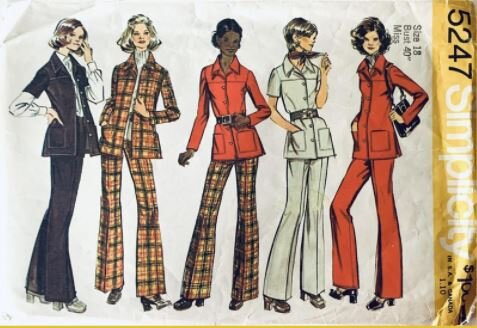Pantsuit Revolution
Pants for women were first introduced during World War I but originally worn for practical reasons.
This photo was published in the Nov. 15, 1938 Los Angeles Times via Getty Images. (Photo by Andrew H. Arnott/Los Angeles Times via Getty Images)
Women were starting to go to work and fashion needed to adapt to these new circumstances, but it was also the designers who thought it might be about time to free women from the reigning corsets and very gender specific dress-codes.
It wasn’t until the mid-1950s, however, that the ensemble was finally embraced by the public. In 1938, a woman in Los Angeles was arrested for wearing pants instead of a skirt to testify in court - the session was rescheduled and she was sent back home by the judges and ordered to wear a dress next time, as pants weren’t seen as appropriate.
Pantsuits started to be more widely accepted during the 1960s and into the 70s, evolving into the pantsuit we recognize today as a modern, sophisticated wardrobe staple for women.
The 1980s saw to the true embrace of pantsuits as a powerful look for women, often with shoulder pads to add an even stronger silhouette.
To the right is Grace Jones on the cover of her album Nightclubbing in a broad-shouldered Armani suit, becoming one of many catalytic forces in pushing the pantsuit to the forefront of mainstream women's fashion.
70s Unlined Shirt-Jacket and Pants in Misses and Half-Sizes Vintage. Sewing Pattern 5247 B40.
United States Secretary of State and Senator Hillary Clinton continued to largely popularize the pantsuit, demonstrating how pantsuits have evolved in conjunction with the women sporting them, many of whom strove to prove their equality and break boundaries within the spheres that were and remain male-dominated.
The clothes women have worn throughout history are tools in illuminating the symbolism of an ever-changing society with evolving norms and expectations. The pantsuit remains an iconic statement for empowerment, and is an exemplification of how fashion and its designers can reflect and affect the times and lives of their wearers.
Pantsuits at the Hart Cluett Museum
Currently, a pantsuit suit is on display in our ongoing exhibition, The Way We Work(ed), highlighting how the fashion of work, particularly for women, has been in continuous evolution.
The pantsuit on display, as seen here, was worn by M. Barbara Urban, a retired teacher. She taught in School 18 from 1964-1976 and then Doyle Middle School from 1976-1998.
On wearing pantsuits she noted:
“In the mid-1970s there was a group of female teachers at School 18 who decided to confront the principal on the issue of wearing pants. She did not think pants were appropriate teacher attire… a group of us entered her office in a body. Before any words were spoken, the principal said that she had reconsidered her position and pantsuits would be allowed. I think the thing that really surprised her was that this little rebellion was not led by us young ‘uns but by the older teachers in their 50s.”





